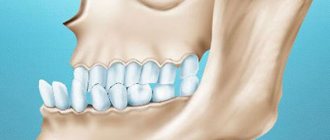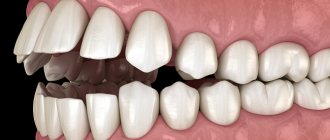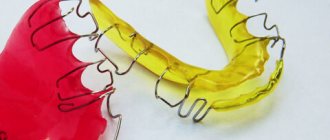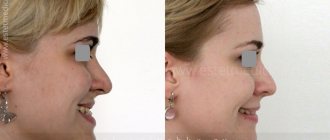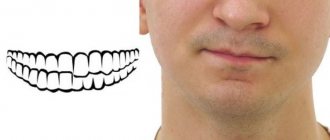When is surgery needed for bite problems?
Specialists resort to surgical intervention when conventional orthodontic treatment methods have failed.
- Wearing permanent braces.
- Treatment with aligners.
- Installation of trainers (the method is suitable for children).
- Installation of veneers (used in mild cases of malocclusion).
- Laser bite correction.
Braces or removable aligners (teeth aligners) in most cases cope with the problem. However, with significant skeletal deformations, which are expressed in the disproportionate size of the jaws, their improper closure, and deformation of the chin, these methods are powerless.
Complex bite pathologies, for example significant closure defects, cannot be treated by wearing orthodontic structures for a long time. Orthodontists do not always take this fact into account. Meanwhile, focusing only on orthodontic treatment can have significant negative consequences for the patient: tooth dislocations or pathologies of the temporomandibular joint are quite possible in this case. And they bring with them completely different problems: pain in the head and back, disorders of the gastrointestinal tract and other diseases that at first glance are difficult to associate with malocclusion pathologies.
Features of the bite correction operation
The operation to correct the bite is performed under local anesthesia under the guidance of an oral surgeon. All incisions and stitches are made inside the oral cavity, so there are no scars or traces of manipulation left on the face.
If the jaw abnormality is congenital, orthodontic treatment is prescribed even in childhood. To correct the bite and change the position of the teeth in the dentition, traditional braces or self-ligating systems are used (another name is non-ligating). The duration of treatment with braces largely depends on the complexity of the case, but on average it takes from 1 to 3 years. Although this method is quite time-consuming, it has the following advantages:
- painless;
- a short recovery period (getting used to discomfort in the oral cavity due to the presence of a foreign body and restoring diction) occurs in a maximum of 1 month, which is much faster than after correcting the bite surgically;
- even applies to children;
- minimal list of contraindications;
- inexpensive (compared to the prices of surgery to correct the configuration of the jaw).
Having read the above list of advantages of wearing braces before surgery, it becomes obvious that correcting the bite surgically is a forced and only measure used if the patient has a significant anomaly in the structure of the jaw bones and the use of the brace system has not brought positive results.
Doctors' recommendation for all parents is to regularly monitor their child with an orthodontist from the age of 5, when the most active growth of the bones of the face and jaw begins.
Timely detection of deviations from the normal structure of the jaw allows the defect to be eliminated as quickly and effectively as possible and to avoid surgery to correct the bite surgically.
When orthognathic surgery is contraindicated
Surgeons will not undertake such an operation if the jaws have not yet formed - in adolescents and children. We also highlight such contraindications as:
- cardiovascular diseases;
- problems with blood clotting;
- the presence of precancerous and cancerous diseases;
- diseases of the endocrine or skeletal system;
- diabetes in some stages;
- disorders associated with mental state.
Specialists will most likely refuse those patients who think that this operation can improve their appearance, even without problems with their bite. With all the possibilities of orthognathic surgery to rejuvenate the patient and improve his appearance, it primarily solves serious problems with bite and should not be perceived as a beauty procedure.
Signs of correct bite
To begin with, we will show what a normal bite looks like and list the signs by which you can understand that it is normal.
- The main distinguishing feature of a correct bite is the tight contact of the upper and lower jaws when they close. The upper front teeth cover the crowns of the lower ones by a third, that is, the lower incisors come into contact with the palatine tubercles of the upper ones. There is no distance between the upper and lower chewing teeth, and during chewing they are in constant contact.
- Correct bite affects the harmony of facial proportions: the lower and upper jaws are symmetrical.
- There are no speech defects.
- Food is comfortable to bite and chew.
- There is no discomfort or clicking in the jaw joint.
Can complications occur after orthognathic surgery?
The result of this surgical intervention is completely predictable, so complications after surgery in most cases should not occur. There may be temporary numbness of the lips. However, in the postoperative period this is acceptable and even helps the patient avoid pain. When the previous sensitivity of the lips returns, there is no more pain.
You can insure yourself against the negative consequences of surgery if you seek help from reliable specialists.
Rehabilitation after surgery to correct bite
Rehabilitation is a long, complex stage that will ultimately lead to healthy teeth and a beautiful smile. In the process of recovery after surgery to correct the bite by surgical method, it is important to adhere to the recommendations of doctors: wearing a splint prevents wide opening of the mouth, yawning, blowing the nose, and chewing. It is recommended to temporarily switch to soft foods and eat pureed foods.
The rehabilitation period includes the following stages:
- Use of antibiotics to prevent the development of infection.
- Wearing a rigid bandage for the first few days after the procedure.
- Daily doctor monitoring of changes in the oral cavity.
- After two to three weeks, the dentist removes the sutures.
- After the doctor has noted positive dynamics, in which the processes of healing and bone fusion proceed without complications, the jaw screws are removed (2-4 months after surgery).
During the rehabilitation process, the patient may experience pain and swelling. Although this is a normal reaction of the body to serious and extensive surgery, it is important to report any complaints to your doctor.
Do I need to prepare for orthognathic surgery?
The preparatory period can last more than one week. As mentioned above, orthognathic surgery is completely predictable. Therefore, at the first stage, the specialist decides what results should be after treatment:
✔
determines the necessary future parameters;
✔
finds the maximum possible number of closures between opposing teeth;
✔
monitors how the results of the operation will affect the patient’s appearance.
In most cases, when preparing for surgery, surgeons use special 3D modeling tools for the result. Thanks to the software, a template is obtained and the paths that will lead to the expected effect of orthognathic treatment are found.
Then orthodontic treatment with braces or aligners begins. This can take from several months to a year and a half. Once the dentition is aligned, orthognathic surgery can begin.
Orthognathic intervention takes 4-6 hours. Then the patient remains in the clinic for another 3-4 days under the supervision of the attending physician. Afterwards you can return home, and after 3 weeks you can go back to work.
Types of malocclusion
How can you tell if your bite is wrong? Essentially, these are all deviations from the norm that nature has established.
Malocclusion occurs:
- distal - the upper jaw is pushed forward more than the lower jaw;
- mesial - the lower jaw is pushed forward more than the upper jaw;
- deep - the upper teeth overlap the lower ones by more than half their length;
- open - most of the teeth of the upper and lower jaws do not meet;
- cross - the left and right sides of the upper dentition protrude forward unevenly, and the upper and lower teeth meet with cutting edges.
What to do in the postoperative period
In addition to following all the instructions of the attending physician, you need to pay attention to several important points.
- You need to apply ice to the jaw area and apply ointment or gel for swelling.
- Strictly observe daily routine and hygiene: get up, walk around, do not smoke, eat.
- Avoid heavy objects, do not bend over, avoid sudden movements.
- Do not hesitate to seek help if there is any discomfort.
The second most popular question concerns nutrition during the postoperative period. Contrary to expectations, the straw does not always help. According to reviews from people who have undergone this operation, it is better to use a small spoon. The only difficulty with eating usually is that it takes longer. In the hospital, during the postoperative period, patients are prescribed a gentle diet, in which dishes are served pureed.
Immediately after returning home, you can choose your usual menu, guided by your preferences. However, at first, the food should still be pureed. If necessary, you can consult a gastroenterologist.
Progress of the operation
Surgical correction of the bite is carried out in our clinic under general anesthesia under the guidance of an experienced chief physician and anesthesiologist-resuscitator and orthodontist. The duration can take from 15 minutes to 4 hours in complex cases. The operation itself includes the surgical stage itself, when access to the bone is carried out surgically through soft tissue in order to correct its position. The surgeon performs manipulations to reduce or increase the volume of bone tissue, or to displace it using a special surgical set and elements for fixing the bone (various splints, screws).
If the patient’s condition allows and there is a need, braces are installed immediately after surgery. After surgery, a fixing bandage is applied to the face. Sutures are placed on soft tissues, and the wound surface is treated.
In complex clinical cases, due to the proximity of other organs to the operated area, we involve the appropriate specialists - ophthalmologists, plastic surgeons, otorhinolaryngologists.
Since the operation is performed exclusively under general anesthesia, it is painless for the patient, under constant monitoring of the condition of vital organs and systems by an anesthesiologist.
What is the cost of orthognathic surgery?
An accurate calculation of the cost of surgical intervention can only be done individually after consultation with an orthodontist and a surgeon in the clinic of your choice. Plus, you will always additionally need to take a panoramic image or computed tomography of the maxillofacial region, condylography. In addition, correcting the bite may require the participation of related specialists.
When searching for a suitable dentist, pay attention to the clinic’s special offers: in some cases, you may be offered to pay for services in installments or in parts.
How is the procedure done?
The operation to correct the bite is carried out under the supervision of an anesthesiologist, an orthodontist and a maxillofacial surgeon. The surgical procedure is as follows:
- The patient is given general anesthesia.
- The surgeon uses a scalpel to expose the jaw bones.
- Work is underway to move the bones into the planned position.
- The result is fixed using surgical instruments: screws, screws, plates with their further fastening with special rubber bands.
- At the end of the jaw plastic surgery, a rigid splint is placed on the lower half of the face to prevent the bones from mixing.
Depending on the complexity of the case, the operation can take from 1 to several hours.
What can a doctor do during surgery?
- remove the lower jaw and move it to a new place,
- break the jaw, remove part of the bone or, on the contrary, supplement it with the necessary segment,
- make an incision on the chin, remove part of the bone or build it up, giving a new shape to the lower part of the face,
- install a metal device that will increase the volume of bone tissue after its preliminary fracture.
Various instruments come to the aid of the surgeon: metal screws, plates and dictators - devices that create the necessary traction on the bone, allowing you to change its shape and thereby the position and size of the jaw.
Before and after results
Results before and after surgery will vary significantly. Depending on the scope of the surgical intervention, the type of pathology or injury, it depends on when the first results of the operation can be seen.
If the surgical intervention was extensive, screws, screws, pins were installed, then the result can be seen in a couple of months. The patient undergoes CT and TRG to assess changes in jaw position.
If screw fastenings were used during the operation, they are removed after 3-4 months, after which the result of the surgical treatment is finally assessed.
The final result of the operation depends both on the professionalism of the surgeon and on the patient’s compliance with all the doctor’s recommendations. The correct behavior of the patient during the rehabilitation period affects the final result of the surgical intervention.
